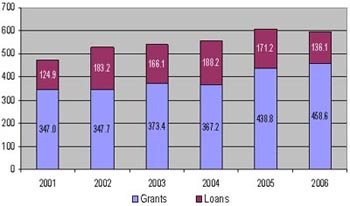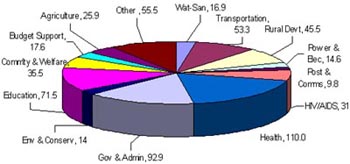 |
 |
 |
 |
||
|
|
|
Executive Summary |
|
|
|
Progress in consolidating the development partnership In its annual review of the development partnership, the AER recounts significant progress but also highlights the need to turn our attention from planning and conducting studies towards a focus on the implementation of the H-A-R Action Plan. Major milestones in 2006 and early 2007 included the preparation of the Strategic Framework for Development Cooperation Management, the completion of a GDCC-TWG Review, and the production of a 'Guideline on the Role and Functioning of the Technical Working Groups'. In October 2006, the Government and most major development partners also recommitted themselves to this joint endeavour by co-signing the Declaration on Enhancing Aid Effectiveness. The Report proposes that it is perhaps now time for taking concrete actions to consolidate the link between aid effectiveness work and the achievement of development results. Analysis of trends in the provision of development assistance - Fragmentation and Concentration The analytical section of the Report demonstrates that the development partnership in Cambodia is characterised by over 30 development partners providing support across a wide range of sectors, with many of these development partners supporting a large number of activities and projects. |
|
Trends in Development Assistance |
||||||||||||||||||||||||||||||||||||||||||||||||||||||||||||||||||||||||||||||||||||||||||||||||||||||||||||||||||||||||||||||||||||||||||||||||||||||||||||||||||||||||||||||||||||||||||||||||
Disbursement Trends (USD million) |
Development Partner Disbursements (USD million)
|
|||||||||||||||||||||||||||||||||||||||||||||||||||||||||||||||||||||||||||||||||||||||||||||||||||||||||||||||||||||||||||||||||||||||||||||||||||||||||||||||||||||||||||||||||||||||||||||||
2006
Sector Allocations (USD million) |
||||||||||||||||||||||||||||||||||||||||||||||||||||||||||||||||||||||||||||||||||||||||||||||||||||||||||||||||||||||||||||||||||||||||||||||||||||||||||||||||||||||||||||||||||||||||||||||||
| Source: CDC Database, April 2007 |
|
Despite efforts to establish programme-based approaches, development assistance is provided mainly in the form of projects, with approximately half of total aid in the form of technical assistance. The Report emphasises the need for more effective aid management practices to be established if this support is to be used to maximise effect. Other significant analytical findings of the Report are:
The main data source of the Report is the CDC Database, complemented by results from the 2006 Paris Declaration monitoring survey and Technical Working Group (TWG) Progress Reports. The Report recognises that data integrity issues continue to be of concern and proposes that further effort by Government, development partners and NGOs to validate the information provided would facilitate a closer alignment of support to the NSDP as well as supporting the evolution towards more evidence-based development management across the priority sectors. Implementation of the Harmonisation, Alignment and Results (H-A-R) Action Plan Having analysed the main trends in development assistance, alignment with the NSDP and different funding modalities, the Report turns to the implementation of the H-A-R Action Plan. Across all sectors and TWGs there is encouraging evidence of progress. In the context of the H-A-R Action Plan's identified priority actions, the Report highlights the following:
This section concludes that, while much has been achieved, Government and development partners must continue to strengthen their partnership and identify practical measures to promote the impact of aid. In this way, their efforts may then have a demonstrable effect on: (i) the reduction of transaction costs and enhanced national aid management; (ii) in utilising technical cooperation so that it contributes more effectively to building national capacity; and (iii) most important, in making a measurable contribution to the attainment of the Cambodia Millennium Development Goals. Identifying a set of aid effectiveness indicators A principal aid effectiveness-related activity of 2006 was the Paris Declaration monitoring survey, an exercise that provides the basis for establishing a set of national indicators to augment the H-A-R Action Plan. Government noted the strong commitment of development partners to completing the survey exercise and to ensuring that the results they provided gave an accurate reflection of how they viewed their efforts to implement the Paris Declaration. Having completed this exercise it was therefore possible to incorporate these indicators into the H-A-R Action Plan, although they may require some further validation before targets can be agreed at the national level. This process can now be efficiently undertaken as, by customising the CDC Database, data on most of these indicators, i.e. those at the project level, can be routinely monitored for sector and national reporting purposes. Based on the dialogue that accompanied the process of completing the survey and this Report, two additional indicators to those used in the Paris Declaration exercise have been added:
The next task in H-A-R monitoring will therefore be to validate the data of each development partner and to consider the nature of any sector-specific aid coordination challenges before identifying additional concrete actions – and associated indicators and targets - that are considered necessary. Consolidating a set of policy-based recommendations and actions By combining the quantitative analysis with the complementary reports provided by line ministries and TWGs, it is possible to make some practical recommendations on how to proceed with the implementation of the H-A-R Action Plan. Other than augmenting the H-A-R Action Plan with a set of indicators, it is not proposed that the Plan be modified but, emphasising the partnership-based nature of aid effectiveness work, it is recommended that the relative priorities and implementation efforts be concentrated on the following actions: Recommendation One: Increased Effectiveness of the Technical Working Groups and GDCC
Recommendation Two: Implementing the Strategic Framework and the CDC Mandate
Recommendation Three: Capacity Development and Impact of Technical Cooperation
Recommendation Four: Promoting Mutual Accountability
Progress in taking forward these recommendations and in overall implementation of the Strategic Framework and the H-A-R Action Plan will be assessed in mid-2008, which will represent the mid-way point in the NSDP cycle. This will provide an opportunity for any revision of the H-A-R Action Plan that is considered to be necessary. Conclusion This Report attempts to establish a closer link between aid effectiveness work and efforts to realise improved development results. The analysis provides evidence-based policy recommendations that may contribute not only to more effective aid management but also to enhanced development results. The Report has established empirically, for example, that Cambodia's aid coordination challenge is formidable and the manner in which aid is programmed, managed and delivered will therefore influence the outcome of development assistance as much as the amount that is provided. It is therefore encouraging that most line ministries, in partnership with their associated TWGs and development partners, have reported making significant progress but, as the 2006 Paris Declaration monitoring survey highlighted, much remains to be done if aid coordination-related activities are to move beyond the level of the cosmetic towards making a real difference in delivering results and to developing national capacity that will sustain progress towards the NSDP targets and CMDGs. It must also be observed that the management of development assistance cannot be seen as an exclusively technical exercise. There are many complexities, concerns and interests that inform the scale and scope of development cooperation. The analysis presented here must therefore be nuanced into the wider discussion related to the role, rationale and desired impact of development assistance but, based on the significant progress made to date, and the demonstrated commitment to partnership, there is every reason to believe that the recommendations made in this Report can be fully implemented. |
|||||||||||||||||||||||||||||||||||||||||||||||||||||||||||||||||||||||||